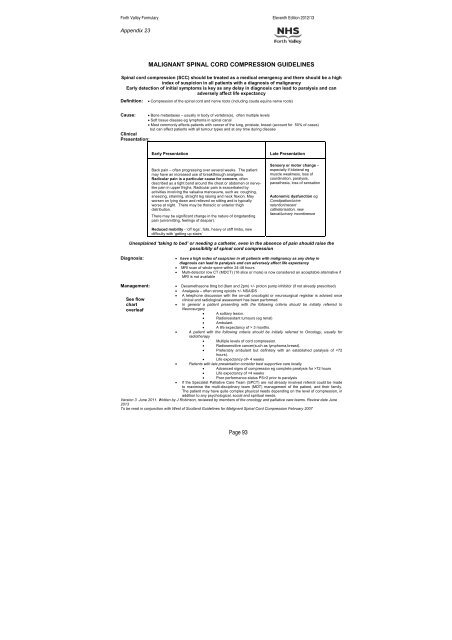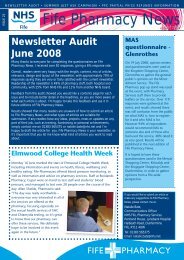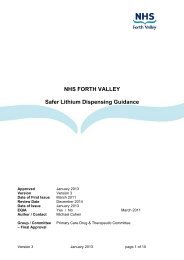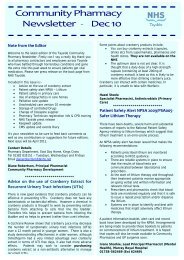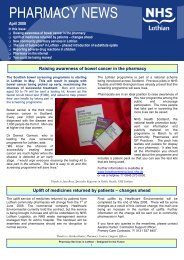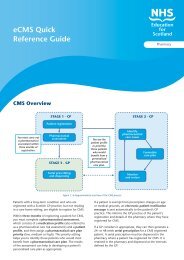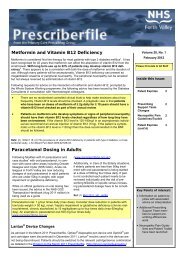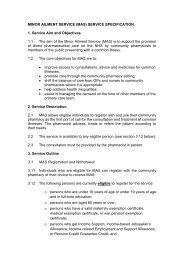nhs forth valley formulary 11 - Community Pharmacy
nhs forth valley formulary 11 - Community Pharmacy
nhs forth valley formulary 11 - Community Pharmacy
You also want an ePaper? Increase the reach of your titles
YUMPU automatically turns print PDFs into web optimized ePapers that Google loves.
Forth Valley Formulary Eleventh Edition 2012/13Appendix 23MALIGNANT SPINAL CORD COMPRESSION GUIDELINESSpinal cord compression (SCC) should be treated as a medical emergency and there should be a highindex of suspicion in all patients with a diagnosis of malignancyEarly detection of initial symptoms is key as any delay in diagnosis can lead to paralysis and canadversely affect life expectancyDefinition:• Compression of the spinal cord and nerve roots (including cauda equina nerve roots)Cause: • Bone metastases – usually in body of vertebra(e), often multiple levels• Soft tissue disease eg lymphoma in spinal canal• Most commonly affects patients with cancer of the lung, prostate, breast (account for 50% of cases)but can affect patients with all tumour types and at any time during diseaseClinicalPresentation:Early PresentationBack pain – often progressing over several weeks. The patientmay have an increased use of breakthrough analgesia.Radicular pain is a particular cause for concern, oftendescribed as a tight band around the chest or abdomen or nervelikepain in upper thighs. Radicular pain is exacerbated byactivities involving the valsalva manoeuvre, such as: coughing,sneezing, straining, straight leg raising and neck flexion. Mayworsen on lying down and relieved on sitting and is typicallyworse at night. There may be thoracic or anterior thighdistribution.There may be significant change in the nature of longstandingpain (unremitting, feelings of despair).Late PresentationSensory or motor change –especially if bilateral egmuscle weakness, loss ofcoordination, paralysis,parasthesia, loss of sensationAutonomic dysfunction egConstipation/urineretention/recentcatheterisation, newfaecal/urinary incontinenceReduced mobility - ‘off legs’, falls, heavy or stiff limbs, newdifficulty with ‘getting up stairs’Unexplained ‘taking to bed’ or needing a catheter, even in the absence of pain should raise thepossibility of spinal cord compressionDiagnosis:• have a high index of suspicion in all patients with malignancy as any delay indiagnosis can lead to paralysis and can adversely affect life expectancy• MRI scan of whole spine within 24-48 hours• Multi-detector row CT (MDCT) (16 slice or more) is now considered an acceptable alternative ifMRI is not availableManagement: • Dexamethasone 8mg bd (8am and 2pm) +/- proton pump inhibitor (if not already prescribed)• Analgesia – often strong opioids +/- NSAIDSSee flow• A telephone discussion with the on-call oncologist or neurosurgical registrar is advised onceclinical and radiological assessment has been performed.chartoverleaf• In general a patient presenting with the following criteria should be initially referred toNeurosurgery• A solitary lesion.• Radioresistant tumours (eg renal)• Ambulant.• A life expectancy of > 3 months.• A patient with the following criteria should be initially referred to Oncology, usually forradiotherapy• Multiple levels of cord compression.• Radiosensitive cancer(such as lymphoma,breast).• Preferably ambulant but definitely with an established paralysis of 4 weeks• Patients with late presentation consider best supportive care locally• Advanced signs of compression eg complete paralysis for >72 hours• Life expectancy of 2 prior to paralysis• If the Specialist Palliative Care Team (SPCT) are not already involved referral could be madeto maximise the multi-disciplinary team (MDT) management of the patient, and their family.The patient may have quite complex physical needs depending on the level of compression, inaddition to any psychological, social and spiritual needs.Version 3 June 20<strong>11</strong>. Written by J Robinson, reviewed by members of the oncology and palliative care teams. Review date June2013To be read in conjunction with West of Scotland Guidelines for Malignant Spinal Cord Compression February 2007Page 93


